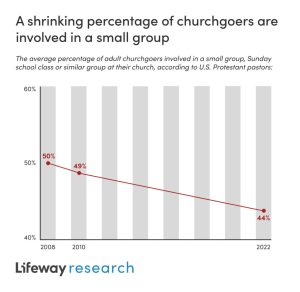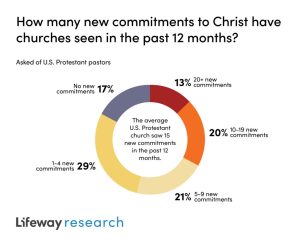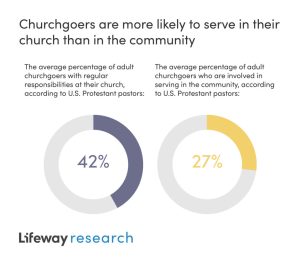NASHVILLE (BP) – As churches continue ministry in the aftermath of the COVID-19 pandemic, many are finding it increasingly difficult to grow their small groups. However, churches continue to report new commitments to Christ and changed lives.
According to a Lifeway Research study, the authority of Scripture is foundational to churches’ groups and discipleship strategies. More than 9 in 10 (97 percent) U.S. Protestant pastors say Scripture is the authority for their church and their lives, with 89 percent strongly agreeing. Meanwhile, 2 percent disagree, and 1 percent are not sure. Protestant pastors have consistently considered Scripture to be the authority for their church and their lives since Lifeway Research began asking this question in 2008.
Even as pastors hold on to the authority of Scripture, it has become increasingly difficult for pastors to move worship attendees into small groups where they’ll study Scripture. On average, Protestant churches say 44 percent of their current weekend worship attendees are involved in a small group, Sunday School or similar group, indicating a decline in average small group attendance since 2010 (49 percent).
Churches are most likely to say 25-74 percent of worship attendees are involved in a small group. While 1 in 3 (30 percent) say 50-74 percent are involved in small groups, 27 percent say 25-49 percent of attendees are in a small group. Fewer (24 percent) say less than 25 percent are involved in a group. And fewer than 1 in 5 (19 percent) say 75 percent or more of their worship attendees are involved in small groups. Since 2008, the percentage of pastors reporting less than 25 percent of worship attendees involved in a small group has increased from 17 percent to 24 percent.
“Small groups and Sunday School classes provide the relational glue that allows a local congregation to be a place where people love one another,” said Scott McConnell, executive director of Lifeway Research. “Groups and relationships that are centered on the Word of God unify a congregation and motivate people to work together on the mission of the church. Churches with few people participating in groups are not in a healthy position to be making more disciples.”
Small churches in particular face significant challenges when it comes to integrating worship attendees into small groups. Pastors at the smallest churches, those with fewer than 50 attendees, are the most likely to say less than 25 percent of their attendees are involved in a small group (39 percent). More churches land in the 50-74 percent small group participation window than any other window. But the smallest churches are least likely to be in this category (21 percent), and the largest churches (attendance over 250) are the most likely (52 percent).
Mainline churches are also more likely to struggle with small group participation than evangelical churches. Pastors of mainline churches (28 percent) are more likely than evangelical pastors (21 percent) to report less than 25 percent of attendees involved in groups.
Commitments to Christ and continued discipleship
As churches have struggled to develop small group attendees, large numbers of new commitments to Christ are becoming less common. In the past 12 months, Protestant churches have seen an average of 15 new commitments to Christ. Churches are most likely to say they’ve seen one to four new commitments in the past year (29 percent). Around 1 in 5 say they have seen five to nine (21 percent) or 10-19 (20 percent) new commitments. Fewer are on the extremes of having no new commitments (17 percent) or 20 or more (13 percent). Compared to 2010, fewer churches today are seeing at least 20 new commitments in a year (20 percent v. 13 percent).
“Previous research has shown people who regularly attend groups share with others how to become a Christian and invite people to church more often,” McConnell said. “As we see less participation in groups, it is not surprising that churches see fewer people coming to Christ.”
On average, 79 percent of new commitments to Christ become active in the life of the church. More than half of Protestant churches (56 percent) retained all new commitments. This indicates a slight improvement since 2008 when 51 percent of churches retained all new commitments.
Once again, mainline churches are more likely than evangelical churches to struggle to gain new commitments. Mainline pastors are more likely than evangelicals to report no new commitments (23 percent v. 15 percent).
Church size is a significant factor for new commitments and retaining those commitments in the church. Pastors at churches with attendance of fewer than 50 are most likely to report no new commitments (32 percent). And pastors at churches with attendance of 250 or more are most likely to report at least 20 new commitments (57 percent). However, pastors of the largest churches (attendance of 250 or greater) are the least likely to have retained all new commitments (35 percent).
As pastors continue to report new commitments to Christ, 9 in 10 Protestant pastors say they are consistently hearing reports of changed lives in their church (90 percent), with 36 percent strongly agreeing. Around 1 in 10 disagree (10 percent). Another 1 percent are not sure.
When considering reports of changed lives, church size continues to be one of the primary factors. Pastors at churches with attendance of 100-249 (96 percent) and 250 or more (99 percent) are more likely than those with attendance of 50-99 (90 percent) or fewer than 50 (82 percent) to say they consistently hear reports of changed lives at their church. Pastors at churches with fewer than 50 attendees are the most likely to disagree (17 percent).
Serving in the church and community
The percentage of adults who attend church at least monthly and have regular responsibilities at the church varies greatly. On average, 42 percent of adults in Protestant churches volunteer regularly. Most churches say at least 20 percent of adults in their congregations serve regularly in the church. Around 1 in 4 pastors say 20-39 percent (28 percent), 40-59 percent (25 percent) or 60 percent or more (28 percent) of the adults in their churches volunteer regularly in the church. But 18 percent of pastors say less than 20 percent of adults in their churches regularly volunteer. That’s a substantial increase from the 13 percent of pastors who said the same in 2008.
Small churches have an interesting relationship with volunteers. Pastors at churches with attendance fewer than 50 are simultaneously the most likely to say less than 20 percent of their adults volunteer in the church (24 percent) and among the most likely to say at least 60 percent of adults in their church volunteer regularly (35 percent).
“Some of the smallest churches are hanging on, often for many years, in an unhealthy position of letting a few people serve. In contrast, other churches have an all-hands-on-deck culture,” McConnell said. “The entire tone of a small church can swing quickly if just a handful more people volunteer.”
Compared to the number of volunteers in the church, fewer monthly Protestant church attendees are involved in ministries or projects outside of the church that serve people in their communities. On average, 27 percent of adults in the church are serving in their communities. Still, this is an increase from 2010 when 22 percent said the same. More than 2 in 5 (42 percent) pastors say less than 20 percent of the adults in their church are serving in the community. Fewer than 1 in 3 (31 percent) say 20-39 percent of adults serve in the community. And even fewer say 40-59 percent (16 percent) or 60 percent or more (12 percent). But today, more churches have at least 40 percent of their congregation serving in their community than in 2008 (28 percent v. 21 percent).
When it comes to serving in the community, evangelical pastors are less likely than mainline pastors to report a large percentage of participation. While 15 percent of mainline pastors say at least 60 percent of adults in their church engage in community service, 9 percent of evangelical pastors can say the same.
For more information view the complete report and visit LifewayResearch.com.
Methodology
Lifeway Research conducted the phone survey of 1,000 Protestant pastors Sept. 6-30, 2022. The calling list was a stratified random sample, drawn from a list of all Protestant churches. Quotas were used for church size. Each interview was completed by the senior or sole pastor or a minister at the church. Responses were weighted by region and church size to reflect the population more accurately. The completed sample is 1,000 surveys. The sample provides 95 percent confidence that the sampling error does not exceed plus or minus 3.2 percent. This margin of error accounts for the effect of weighting. Margins of error are higher in sub-groups.
Comparisons are made to the following phone surveys conducted by Lifeway Research:
- A phone survey of 1,000 Protestant pastors conducted Aug. 29-Sept. 11, 2018, sponsored by the Billy Graham Center for Evangelism at Wheaton College
- A phone survey of 1,000 Protestant pastors conducted March 1-9, 2010, as part of Transformational Church research
- A phone survey of 1,002 Protestant pastors conducted Oct. 13-29, 2008, as part of Transformational Church research








